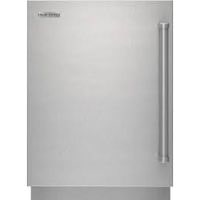Sub zero refrigerator troubleshooting. The typical lifespan of your average refrigerator is 10 to 13 years. If you notice that your would-be Sub Zero isn’t performing quite the way you were expecting it, then it may be time to get started on some troubleshooting.
There are some pretty lightweight DIY solutions for common issues! This guide will walk you through the steps you can take before calling in the professionals.
Getting a handle on troubleshooting and repairing parts yourself can save you a lot of money – which we know is important when buying something this high-priced.
Sub zero refrigerator troubleshooting
Knowing where to look is key to solving almost any problem. We’ll help troubleshoot common reasons for a Sub-Zero refrigerator not working which may require an easy solution or may also require a repair.
The Sub Zero refrigerator isn’t cooling
The condenser fan motor can draw hot air across the evaporator coils and through the refrigerator. If this motor is not working properly, the refrigerator may not cool properly.
To test for a defective motor, first, check for obstructions in the fan blade; then try turning the blade by hand. If it does not spin freely, replace the condenser fan motor.
The condenser coils are usually located under the refrigerator. As the refrigerant passes through them, they dissipate heat as it travels through the coils and is cooled by the ambient air surrounding it.
Without airflow, this cooling process cannot occur and so if the condenser coils are dirty, they will not be able to dissipate heat effectively.
If there is excessive dust or grime built up on the condenser coils, there may be a buildup of debris that has the potential to overheat your fridge, literally.
If your refrigerator’s compressor is struggling – or worse yet unable to keep cool in then you can be assured that you have a serious problem when it comes down to addressing this issue.
Ice maker is not working
There might be a problem with the ice maker assembly. This is because many of the components are not sold separately and many manufacturers do not stock all of the replacement parts that go into the production line so your only option when this happens is to replace the entire ice maker assembly (usually to save money).
This doesn’t mean that you need to buy a new one right away though and here’s why: before doing so, make sure to check if there’s water coming in through your appliance’s water source as well as by testing for any obvious signs as to why this may not be happening properly via your refrigerator/freezer’s water pressure and temperature.
If neither is a problem, your machine isn’t producing enough cubes/blocks or no cubes/blocks at all (even after replacing both the water filter and ice maker) then you will have better luck with a new model.
The water dispenser does not work
A clogged water filter can make it difficult for the ice machine to provide overflowing ice. A water filter should be replaced every six months to prevent the malfunctioning of your ice machine due to a restricted coolant supply tube. If your ice maker isn’t dispensing clean ice, check that the lower water supply hose isn’t frozen.
Defective ice dispenser
The dispenser board is responsible for a lot of the functions of your particular device. If the control board is faulty, it may stop powering the entire dispenser.
You should determine the integrity of the other components before you suspect the main control board; it’s possible that only one part of the dispenser system has failed.
If everything else seems to be working, there’s most likely nothing wrong with your business’ main control board. The dispenser switch is also an important part to look at as well because if this little guy isn’t getting power then your entire machine will be out of order OR not working properly.
An easy way to test this would be by using your multimeter (an instrument used for testing electrical circuits) and just making sure there’s continuity.
The Refrigerator is noisy or loud
If the refrigerator is noisy or loud, especially when one of the doors is opened, either the evaporator or condenser fan blade may be at fault. First, check out the evaporator fan blade in the freezer behind the back panel.
If it’s not rubbing against something or stuck on an obstruction then try turning it by hand to see if anything feels stiff. If it doesn’t move freely then you might have to change your evaporator fan blade.
Check your condenser fan motor thruster behind the base of your refrigerator. If it isn’t reading smoothly then first unplug and inspect any obstructions that could cause excess friction so you can replace them. When both blades are clear, make sure they still work.
The Refrigerator is not defrosting
The defrost timer oversees when the refrigerator should go into the defrost cycle. If it malfunctions, the refrigerator will not run a proper defrost cycle. Before replacing it, test the defrost control and defrost thermostat for continuity.
The defrost control and defrost thermostat must have continuity for the refrigerator to run a proper defrost cycle. If both parts have continuity, replace the evaporator temperature sensor located near one of the coils.
If either part does not have continuity, replace the heater/defrost module assembly located above or below (depending on which type you have).
Refrigerator leaks water
The water filter may be broken or needs to be replaced. Inspect the water filter housing to see if it has any cracks. If you discover any cracks, replace the water filter head with a new one that meets your refrigerator’s model specifications. Failure to do so will cause the unit to leak upon its next use.
The refrigerator freezes food
The temperature control thermostat directs voltage to the compressor, evaporator fan motor, and condenser fan motor if applicable. If a faulty TCT is not working properly, it may cause the refrigerant system to run longer than necessary.
As a result, the refrigerator will be too cold. To determine if a thermostat is defective, rotate it from the lowest setting to the highest setting and listen for a click.
If there’s a click, then it’s probably fine and you don’t need to replace it. However – if you don’t hear a clicking sound at all (or hear nothing after moving it up or down), use a multimeter to test for continuity. If the temp control t thermostat has no continuity at any setting then replace it.
Related Guides
